Blog Archives
3-6 Aug 2014 – Permanent marker, an argument with altitude & fabulous Fatima
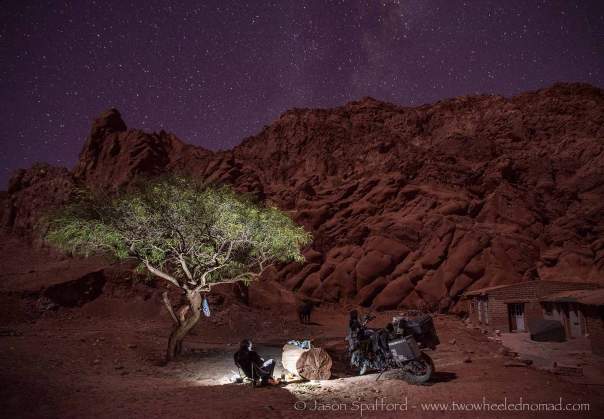
Wild camping in Purmamarca
Our lives six months after saying our heartfelt goodbyes in old Blighty – no longer concerned themselves with mainstream matters on which the average Brit might dwell: work, bills, making some imaginative weekend play before the cycle’s put on repeat. Our affairs now involved: getting from A to which B faring through foreign lands in often unpredictable conditions. Risk assessment, daily contingency plans, expectation management and damage limitation. As well, on-the-road health, our welfare in the wilderness and staying sane with each other 24/7 while riding a rollercoaster of emotions. Sourcing fuel for both bikes and bodies alongside motorcycle maintenance. Budget management where every purchase is a ‘considered’ one from shampoo to sprockets; wear and tear on our gear – can I live with the four finger holes in my gloves or would another patch job using dental floss extend their life a little longer? It’s a two wheeled nomadic life, which, I’ve said before – I love more than yesterday, less than tomorrow.

Up at over 4,000 metres
Why do I find it so thrilling to travel by means of motorcycle? Getting from A to B on all manner of terrain under my own steam perhaps? It was a gamble that I’d fare fortunately astride the saddle long-term but not all risks lead to ruin. I would have only brooded on the road not taken although threw plenty of oil on my fire of fear beforehand. Having already ridden over 9,000 miles I’m so puffed up with pride towards Pearl. Pray continue old girl. I love her like a person! It’s empowering to live on two wheels, it’s like nothing else in my former life on English soil. Total autonomy combined with flexibility governed only by an unquenchable thirst for exploration, coupled with letting go of all the controls that I hadn’t really harnessed to begin with breeds spontaneous excitement. And rich opportunity for firsts coexisting with the unknowns outside the comfort zone just waiting to be unearthed and experienced. Am I getting somewhere close to the answer?
No one day’s the same, the people we’re meeting and experiences we’re having is a life for which I think my soul had always yearned. The same applies to Jason. We’ve traded the life conventional for the ride of a lifetime. It’s already left me with a brighter spirit in which to retell tales on the road with a hungry gusto. I’m not sure if I’m riding to write or writing to ride, I think it’s both. It’s adding another meaningful layer for me anyway. I want a life worth living where it matters not how many miles I ride, nor what bike I ride those miles on or even where. Whether it’s a Honda C90, a Harley or even a Goldwing, the only thing that really matters is you’re enjoying yourself, mindfully. Truth be told, it’s the first time I’ve felt fulfilled…
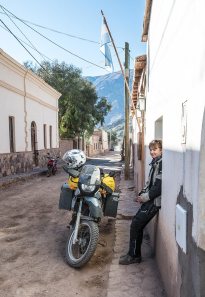
Purmamarca

The hustle bustle of Purmamarca, a bohemian jewel in the desert
Salta on first impression was another biggish city screaming with traffic, noise and negligent road users. I would’ve been happy to keep riding but it was approaching dusk and I was ready for a rest. We spent a sweat-soaked hour ‘hostel shopping’ to accommodate our daily lodging demands – within a strict budget. It had been punishingly hot and sticky all day when I found out that my mother had suffered two recent mishaps – and on an empty stomach feeling capricious, I overreacted at something picking up on Jason’s grouchy tone. I had a grievance about God knows what and couldn’t let it go; like a mastiff with a bone I had to gnaw it down to splinters. The pressures of the day had been coiled up for too long – I royally fell out of favour with Jason. A long day on frayed patience.
We’d planned to stay in Salta for a few days on others’ firsthand recommendations – despite the odd colonial building glimpsed I had still wanted to make a sharp exit on arrival. Thank goodness for happy accidents. Salta’s silver-lined serendipity emerged through its BMW garage – Berlin Motos, whose employees accommodated Jason’s bike on the spot. They were pleased to replace a valve-cover gasket for just over forty pounds labour cost saving Jason the hassle, making some timely tweaks on top from recent wear and tear. It was the mechanics’ Saturday and they stayed open longer than their assigned half day for us. Superb staff that deserve the highest commendation.
Ruta 9 took us out of Salta onto a 4 metre wide road, not a single track but split into two lanes for oncoming traffic. Narrow was an understatement although we cared little and less; we were riding through 30 degree delight. The slender road snaked through a sub-tropical rainforest – it felt like we were following the frilly hem of a rah-rah skirt as we meandered through a multitude of tight twisties. All I could hear was the song of freedom that the wind sang as I fell into a pendular rhythm to its melodic tune. There were butterflies fluttering past my face, a crested caracara lunching on a lizard and a sparkling lake tucked off the main drag. We parked under cover of an ancient tree making a perfect picnic spot for our midday munch. It was not always but that day was a charmed one.

The Seven Coloured Hills of Purmamarca
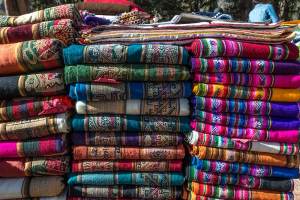
Woven fabrics in a rainbow of colours
Purmamarca we pronounced as ‘permanent marker’ was no broader than the tip of one. As a flyspeck town, it sat against Cerro de los Siete Colores – the Hill of Seven Colours, which can only be described as a jagged rock formation resembling the marzipan fantasy of an over-zealous pastry chef. The village makes its coin by the congruent rainbow of colours interlaced through woven goods and handicrafts on offer. You could buy anything from a hat, poncho and slippers with a matching hippy handbag. A straggle of ochre adobe houses and age-old algarrobo trees next to a bijou 17th century church surrounded the hubbub of the central plaza.
The place was bustling with hordes of holiday-makers, although we found our own personal snuggery for the night away from the packs of people. Ensconced within the heart of the seven coloured hills we chanced upon a local guy whose beret barely covered his shock of black hair. He was somewhere in his fifties, placidly looked up with enquiring eyes while tending his four horses. This guy was unhurried in and unruffled by life. Some revealing chitchat later, we were cooking on the stove, sharing our coffee with Pedro and his two young apprentices with permission to stay over on private land; we laid out only the sleeping bags for a starry night’s sleep. Our wheels had won us the jackpot, yet again.
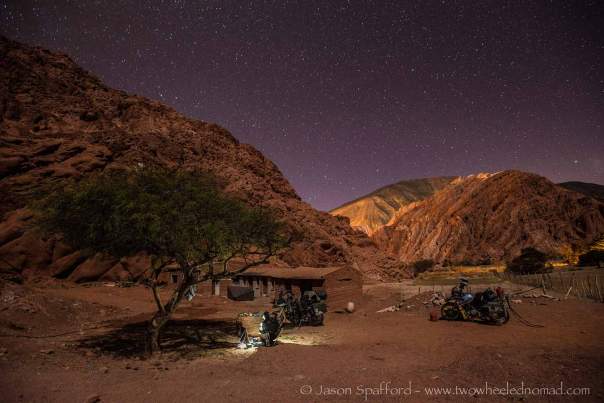
Laying down just the sleeping bags for a starry night in the desert, Purmamarca
My ears the next morning popped to the sound of corn kernels bursting open. We surpassed the height upon the summit of Borneo’s Mount Kinabalu, over 4,000 metres – there’s a footslog I’d never forget. It wasn’t Everest although I was still light headed and short of breath between jumping in and out of the saddle to take pictures. The day ended somewhere off ruta 9 in the region of Jujuy at a spit and sawdust settlement, Susques. We joined the road workers at an unmarked café and chowed down a meal for less than two pounds. Bargain beaut.

Staring up at the stars
Our day from Susques on ruta 52 had started at -7 degrees. In fact the morning saw our coldest day yet in the coolest of sunshine. Moreover we were riding at around 50 miles per hour, which further lowered the unforgiving temperature courtesy of the wind chill. The day previous, we’d been slathering on sun cream, wearing the minimal of clothing. I simply didn’t think ahead and dressed according to balmy breezes and a warm window of sun. I’d blown a fuse on my bike so thought nothing to donning a thin base layer as opposed to my heated jacket, temporarily out of action.
I confess, after an hour or two riding in a raw -7 without my heated gear I was running low on heat reserves. Wearing a face etched in anguish, I was cold as ice clad in goosebumps, every breath laboured. My hands were turning a purply shade of blue with a white band across my knuckles and joints where blood had taken its leave. I was starting to shiver uncontrollably while trying to fight my inner ‘ginger whinger’ rearing her ugly head. It was no good. I pulled over stiff as stone to warm my fingers on Pearl’s exhaust, but not before letting myself wallow in a pitiful but cathartic cry. My affinity with the climbing altitude left much and more to be desired; I guess peaking our ride at 4,800 metres was pretty high, almost on a par to Everest’s base camp. My heart was punching out every heartbeat, I felt fatigued and my skull was pounding in what felt like an expanding head. Get this helmet off! My weep was worth it. With the mini-thunderstorm on my face over, I glugged down my grogginess with water and drank in the vista before me.
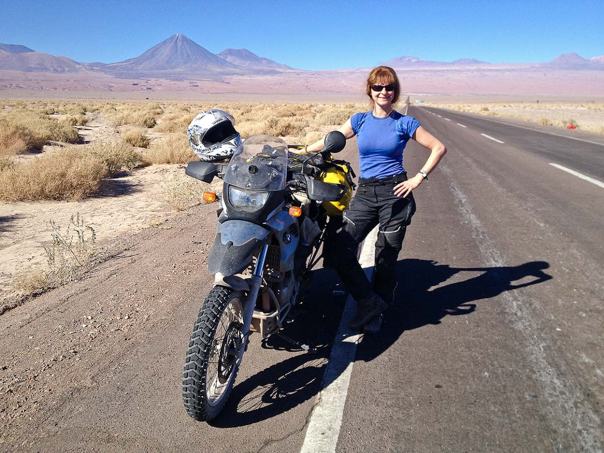
En route to San Pedro de Atacama in Chile
The low sandy hills were all soft lines and gentle curves in calming hues of dusky pink, salmon and peach. They sat serenely on the outskirts beneath a perfect blue sky unblemished by not a whisper of cloud. It was a visual banquet that seemed to keep further brushes with altitude sickness or hypothermic symptoms at bay – although wriggling into additional layers on which I could quickly lay my hands helped. We re-entered Chile for the umpteenth time on ruta 27, destination: San Pedro de Atacama. The day’s misadventure had passed and it gradually got warmer as the afternoon wore on.
Rolling into San Pedro de Atacama was a whopping 30 degrees higher than the morning’s rude start. I looked ahead to the oasis town but on my left spotted volcano Lickancabur – not too difficult to miss at just under 6,000 metres – which if carved down the middle, one half belonged to Chile the other Bolivia. The town itself was a bohemian jewel in the desert. Geared up for the day-tripper yes but it still retained something special and pocket-sized about the place. I liked it.

Rock gazing in Desierto de Atacama

The fabulous Fatima!
Fatima warmly greeted us on arrival at Hostel Tuygasto. What a sweet natured, well-informed and helpful lady. Not comfortable until she had given me a tour of the premises, ensuring I knew how the oven worked, to manage the tricky door lock and which was the hot shower tap, was she at ease. She thanked me for early payment with a receipt, gestured if I had any questions waiting with patient eyes for my response and resumed her cleaning duties around the hostel’s courtyard. I couldn’t remember the last time I’d been accorded with such courtesies. She was nine years old! I could not have been more astonished if John Lennon had come along juggling lemon pies. I adored people like her, she melted my heart in half a beat and it didn’t take more than a thimble of sense to realise why – her father exuded a gentle bonhomie about a happy aura as well.

Atacama desert
29 July – 2 August 2014 – Sun, sand and Salta!
Santa Cruz, Copacabana, San Jose and Londres (also known as London) – what do they all have in common? They’re all the names given to friendly little towns of dusty dwellings, doing their individual Argentinian ‘thing’, a world apart from their counterparts elsewhere on earth. Most boasted tree lined central plazas bearing ripe oranges and one had a cluster of trees whose trunks were patriotically painted in Argentinian flag colours – blue and white. Heat shimmers rose off the road as we rode through the aforementioned towns en route to Santa Maria, giving a dreamlike quality to our surroundings ahead.

Desert by night
Passing through Tinogasta was perhaps more memorable. It was akin to a waste disposal bin overflowing with litter; piles of plastic, used tyres and unwanted household items strewn about everywhere. Pretty this place was not. Around a corner, a snarling Alsatian flung itself towards Pearl and me. The pair of us was a split second away from being grappled by a voracious dog suffering clear anger management issues and sporting a love for wrestling moving motorcycles. I opened Pearl up and off we shot, just out of reach from the mongrel’s gaping maw. Phew. Yards down the street saw a bunch of ragtag lads charging on their mopeds, some being lairy wolf-whistling louts, others paying no one else any mind. A rowdy duo ‘two up’ in particular made me chuckle as the rider beamed a dashing smile my way and waved wildly, while the pillion gave me the finger. At least the motorcyclist was a decent chap!
In hindsight, Londres would’ve been a spot worth staying over in. We only stopped for the morning. It was a Spanish settlement home to some Inca ruins of El Shincal. We climbed one of two hillocks – aligned with the rising and setting of the sun – to survey the vast valley to the south. The mingling of deciduous trees and cacti-prevalent desert flora formed a fascinating ecological paradox. The sun was a white hot penny beating down like a fiery hammer, which in South America’s winter was perhaps another charming contradiction. It was the first day in months the weather had permitted us to strip layers of clothing and ventilate air through our suits, as opposed to locking out the cruel cold to keep the insulation in. Unlike Tinogasta, our passage through Londres caught us both unawares; we radiated in practically the whole town’s warmth towards us: waving, tooting on their scooters, kids running after us and people gravitating towards the bikes I guess to seek out a story and take back to their family and friends. I still forget how the bikes sometimes magnetise people to us, it’s marvellous.

The Ruta del Adobe, the road of clay on Route 40 turned into the Ruta del Vinos, the wine road that took us to Cafayate. Argentina’s second largest wine region, which was as lovely as it was grapeless – go figure in South America’s winter. Cafayate to Cachi took us via La Vuelta a los Valles – Return to the Valleys. Oh my, what a ride! Valles Calchaquies oozed a seductive, off the beaten track rugged landscape. Perhaps the most soul-singing off roading we’d experienced in South America to date. We encountered: bee eaters flying above, gravelly sand, sandy gravel and well, more sand. Inevitably we stumbled through some rough patches of sand, me more than Jason. I performed a beautiful head slam into the sandy roadside at slow speed, had one of those ‘Pick yourself up, brush yourself off’ moments like a dog shakes water from its head. My helmet had come into its own, splendidly saving my noodle and some!


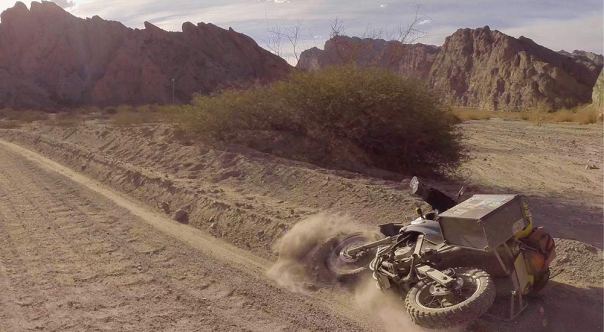
And she’s down!
Up at one of the dusty settlements en route to Cachi, Jason met a guy who had fought for the Malvinas in the Falklands War. He showed Jason a big scar running down his thigh from being shot. Needless to say, he wasn’t too fond of Maggie Thatcher. Further on, we got caught behind a farmer’s flock of sheep up a stony hill. I cooed at the lambs although my attention soon got distracted by the sheeps’ shiny black balls popping out their rears like Mint Poppets at a chocolate factory, creating a handy breadcrumb trail for me to follow. I was so ravenous, they almost looked appetizing.

Vernacular architecture was common in the valleys that to my mind deserved some special attention – even I couldn’t fail to notice some of the adobe houses that boasted neoclassical columns and Moorish arches. Cachi was full of cobblestones, boasted a tranquil plaza overlooked by noble mountains and led us on a road that crossed the Parque National Los Cardones. Interestingly, the local furniture was made from the wood of cacti, cardon; in the treeless Andean foothills and puna, it’s an important timber source and can be seen everywhere up in northern Argentina. It has a distinctive Morse code pattern of dot and dash shaped knots running through the wood. A superb little spot in the desert and one I’m glad we took the time to deviate from our route to Salta and discover.

Our passage to Salta saw the prettiest proliferation of cacti I’d may be ever seen. In the space of an afternoon, the diversity of landscape became borderline ludicrous. One minute it felt as Mexico as cactus populated sandy plains can get and around a corner we peaked our ride at 3,300 metres to feast our eyes on Icelandic foothills. They looked completely covered in cocoa-powder – not what I expected after the desert scene previously encountered. We decided to deviate off road down a rocky track with the odd sheer drop and holes in the road; it got my heart racing as I chose a careful downward line in first gear. I narrowly avoided a steep ravine although had been practicing my weight shifting technique, which paid dividends on Pearl at that moment. Going back up was a piece of cake by comparison. A few miles further, we entered a New Zealand inspired Lord of the Rings scene that transformed into a sub-tropical rainforest, which in turn altered into Scottish hills and then lush green English farmland. All in the space of an afternoon. All in the smallest segment of South America – a slice of Argentinian pie I could continue to dine out on for months.

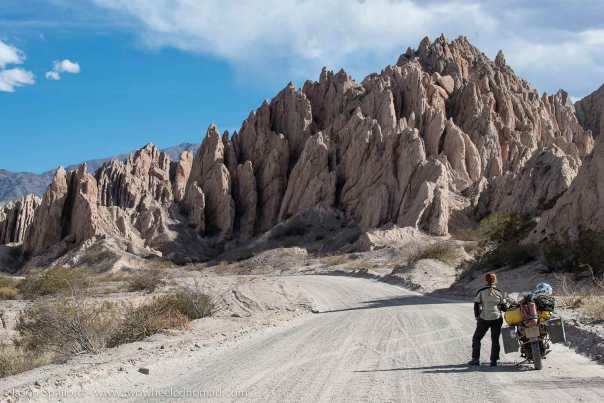
24 – 28 July 2014 – An idiot, a Rodeo without broncos & a Sphinx

A breathtaking night sky and the Milky Way
Barreal’s playground on the crazy paving dried mud lake had been a hoot. We continued on ruta 149 but de toured eastwards for a pit stop in San Juan; Jason’s bike was screaming out for sprockets and a new chain. He was carrying a set from Santiago; it was just a case of replacing old for new. Jumping back on the 149 with a carefree spirit for the life unconventional, I sharply sucked a breath of air in as a four by four driver – evidently harbouring a death wish for himself and those jinxed mortals around him – made a kamikaze swerve around me, overtaking seconds before the brow of a hill. The oncoming car charging over the crest of the hill abruptly veered off road into the dirt to avoid collision, while I slammed both brakes on and did the same. All three of us had missed one another by a hair’s breadth. I felt nauseated by this idiot’s recklessness. The near miss threw me firmly out of the carefree camp and into a pensive one. Although I’d encountered worse drivers and had yet to come across a lot worse, spending another one of my nine cat lives was not to be shrugged off lightly.
On a side note about carnivorous mammals – riding over 8,500 miles in South America I’d so far: seen not one cat corpse but countless dead canines by the roadside, espied cadaverous looking dogs of whom are ubiquitous in Argentina and discerned if you stand still holding a sandwich for long enough, a mongrel with starvation swimming in his eyes will be peering up at you. To my mind, the absence of ameliorating the welfare standards of wild and stray dogs was one of the few things that besmirched Argentina.
I made amends with my morning’s narrow escape and my mood lightly lifted as the day wore on. Far off in the distance, sunlight shimmered off sapphire blue water. We stopped three kilometres outside Rodeo to have a look and kicked the side-stands down at Dique Cuesta del Viento, a perfect place to make peace with the world again. Shame there weren’t any kitesurfers taking to the wind or windsurfers whizzing past on this world famous reservoir, if naught else it was still beguiling as artificial lakes go.

Rodeo was a quiet sleepy town; folks sauntered along the street, while others strolled with an unhurried leisurely air. Unfortunately, the town didn’t take its name on lasso-swinging cowboys buckarooing their broncos but there were gauchos’ horses – belonging to Argentinian nomadic cowboys’, placidly grazing nearby. As I rode further, I peeked at picturesque adobe houses made from a kind of clay, many intermingled with small shack like shops advertising their wares or local fare on makeshift signs. The empanadas – a pastry crescent shaped parcel of hot minced: beef, onion, egg and olives – were full of flavour, fresh from the oven and cost pennies.
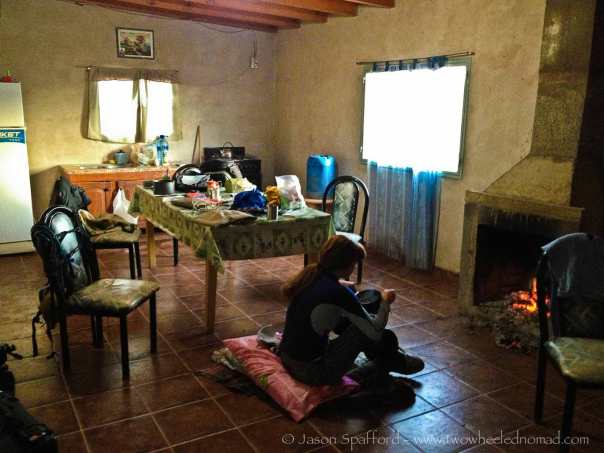
Our desert hideaway
We chanced upon a hostel 50 Nudos off the village’s happily trodden track, which was as rustic and restful as it was idyllically remote. Even the big and little resident dogs scampered up to me without boisterously barking their chops off. The auburn haired, floppy eared sausage dog won my vote and I don’t ordinarily seek pooches out. With imploring eyes, I bartered an affordable rate with the hostel owner and thanked him with all the gratitude I had. Our budget wasn’t an infinite resource by any stretch and credit to this kind man, he needed his pricey rooms occupying in low season as much as we yearned a comfy bed.
Back on the renowned ruta 40, we’d ridden an inverted ‘V’ from Rodeo and had travelled north for half a day only to veer south again on the 76. Shrine filled caverns honeycombed the hills, as they so frequently did. Legend has it that during the civil wars of the 1840s Deolinda Correa followed her husband’s battalion on foot through the desert carrying provisions and her baby. Her supplies ran dry, she passed away from extreme hunger, thirst and exhaustion. When muleteers found them, the baby was reported to be suckling at the dead woman’s breast. Commemorating the miracle of the baby’s survival, shrines referred to as Difunta Correa (meaning ‘defunct’ and her surname respectively), symbolise her soul, one that performs miracles and intercedes for people. Devotees, particularly truckers leave gifts such as bottles of water to quench Deolinda’s thirst at said roadside shrines in exchange for supernatural favours, and this happens from Ushuaia all the way to La Quiaca on the Bolivian border.
The sienna coloured mountains and wild-west forked cacti poking up amid rusty red rock within Parque Nacional Talampaya made the long straight stint through the desert down to Los Baldecitas worth the wait. The lady of a fully occupied hospedaje – homestay directed us to a nearby shabby clay house situated on a sandy floor. At a fiver per person (in British pounds), we had everything and more we needed: a roof over our heads, an open fire and a Bobby Dazzler view of the desert with flocks of green parrots flying overhead.

The day had been a chilly one, we had set off in sub-zero temperatures only for a clear starry night to follow suit. When I tucked Pearl in for the night, pain shot up my legs as my half-frozen feet began to thaw in the warmth. I curled up around the fire with a wind-scoured face and a good book. Relaxed and subdued, I let my eyes devour the fire while the flames licked at my bread. Paperback in one hand and toast in the other, the blaze was all acrackle – flickering light dancing across the planes of our faces. More wood enlivened the fire, as fiery dancers woke within each stick of wood to whirl and spin in their glowing gowns of yellow and orange. I was done for another day.
A fresh 17 kilometre ride blasted out the cobwebs, as well as the sleep from our eyes and took us to Valle de la Luna. Valley of the moon is a 630 square kilometre UNESCO park, a desert valley that sits between mountain ranges Cerros Colorados in the east and Cerro Los Rastros in the west. It takes its name from the Diaguita word for ‘land without life’. We rode into a sandy scene of cacti and rock formations steeped in rich mineral layers: creamy white calcium, pistachio green copper, bile yellow sulphur and terracotta-tinged iron, which looked super-imposed against a cloudless blue sky. All that was missing for a spaghetti western movie set was the prairie-grazing cattle, fast flowing rivers and horse-mounted cowboys.
During a 40 kilometre paid tour on the bikes following a procession of cars, we listened intently to how complete specimens of dinosaur skeletons had been found from the Triassic period, preserved so perfectly inside the layered sedimentary rock infused with its safeguarding substances. Fortunately, our tour guide Florencia was relaxed and allowed us to hang back, disappearing from view more oft than not and foremost the throng of tourists.
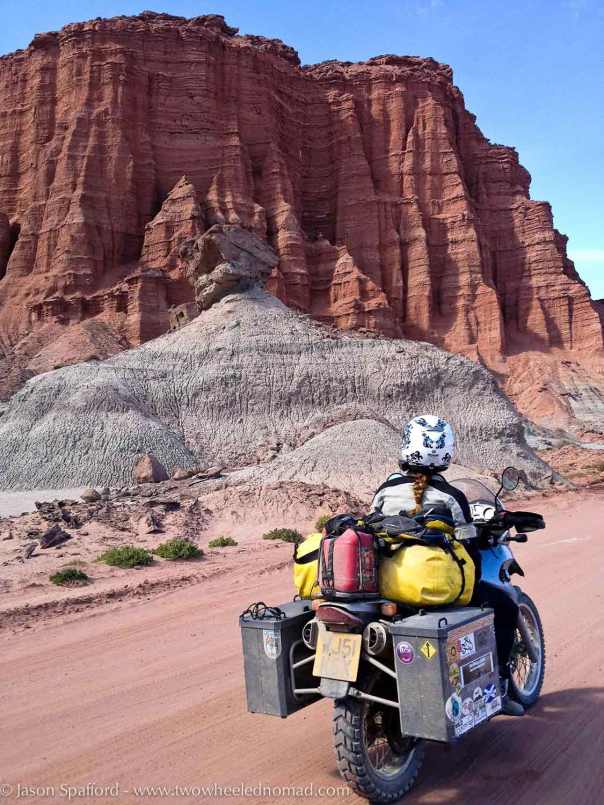
Valley of the Moon
Over millennia at every meander in the canyon, the waters of the dry River Ischigualasto had carved shapes in the malleable red sandstone, monochrome clay and volcanic ash. I didn’t think much to the ‘submarine’ or ‘worm’ but rather liked the ‘Sphinx’ with an uncanny resemblance to a lion’s body wearing a woman’s head. It was an incredibly raw remnant of the Mesozoic Era, representing an ancient segment of our evolution. Riding around the place on motorcycles was a fittingly first rate way to see the place.

The Sphinx!

Valley of the Moon
Around and up one stony hill, our eyes settled on a octet playing traditional Argentinian music with a variety of string and wind instruments. Two professional dancers were also ballrooming to the tango. Their intense eye contact with one another, fixed postures and abrupt pauses made quite the surreal scene against a backdrop of rocky desert. I smiled as I sipped on a drop of complimentary Malbec enjoying the ambience – at that point I succumbed; ditched my helmet and donned the ‘tourist hat’. I imagined having the place to ourselves at night under a full moon would be equally as impressive – roaming on a moonscape of grey dunes in twilight. Eerie but enchanting…
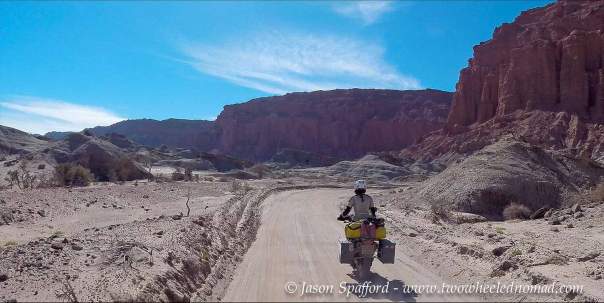
Leaving the Valley of the Moon
A delicious languor was stealing over me while time stole away from us – by the time we’d slowly meandered over sand – me partly careening and Jason gliding – back to the park entrance, it made sense to return to our desert hideaway. The thought of another open fire and hot toast laced in Dulce de leche was too good to deny. Dulce de leche is a thick, toffee coloured milk caramel spread, which unlike dark green vegetables, can be found anywhere in Argentina. It’s so sweet that it will all but dissolve your tooth enamel upon contact. I was becoming dangerously addicted to the stuff. Wood laid and lit, the first flames appeared shy as a lamb, darting and dashing from tinder to log. Moments later, fire once again engulfed the hearth and us in a radiant heat. It was a bliss that blazed for hours, reaping from life’s elemental but nourishing charms.
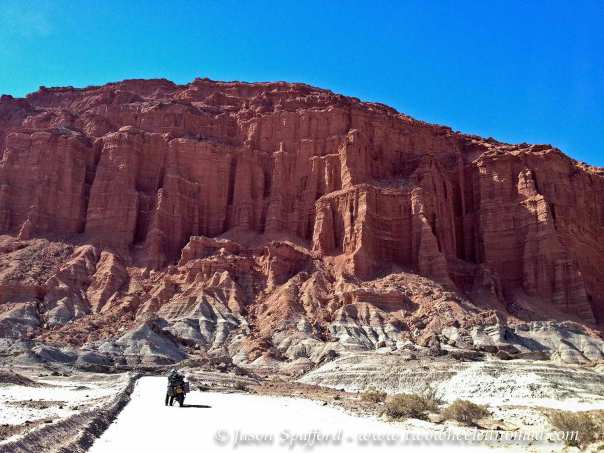
14 – 23 July 2014 – Highs and lows: as many literal as metaphorical
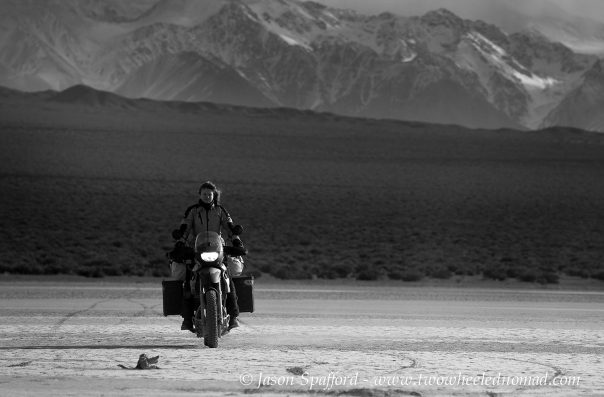
Our seven-day sojourn in Chile’s capital was protracted because of having to stay put for parts to be replaced and spares to be shipped. Three weeks of languidly waiting around had come to an end. If there had been any quiet little moment of peace to savour about the late night drum beating, World Cup cheering, zoo-captive monkey howling city, it was upon reaching Cerro Santa Lucia. Smack in Santiago’s hustle and bustle, we chanced on an old park of steep stoned steps haphazardly lodged in a hill leading up to a stellar view. The hill was a remnant of a volcano 15 million years old.
Before tracing my way up, I came face to face with a goat head dominating an ornate vase, proudly protruding above the Neptune fountain. There was an unusual coolness emanating from the green oasis all about me, goosebumps spread at warp speed from wrist to shoulder. It felt refreshing, especially after returning from local ride outs with black marks smeared on my face every time – the air was that filthy. As far as soaking up a place was concerned, I was starting to feel like a dirty, saturated sponge. On the cobbles part way up I caught sight of a few hummingbirds hard at work, thrumming about the colourful bracts of a pink Acanthus flower. It was the prettiest part amid the urban sprawl I’d seen and treasured these gems to purify if not help redress my somewhat skewed view of this fume-fogged metropolis.
Swopping the hazy smogsphere that smudged Santiago and its litter lined roads for Andean mountainside brought us relief as our lungs inhaled long and deep on fresh Chilean air. The air we’d supped on over the last 21 days had been a noxious soup of God knows what spreading a miasma of odours that just weren’t able to dissipate in a clogged up city. Back on Ruta 5 towards Los Andes, a growing absence of vehicles coughing and spluttering gave way to a more oxygen-rich ride – acting as a filter for the brain, a way to ease my mind back into calm and untroubled thoughts.
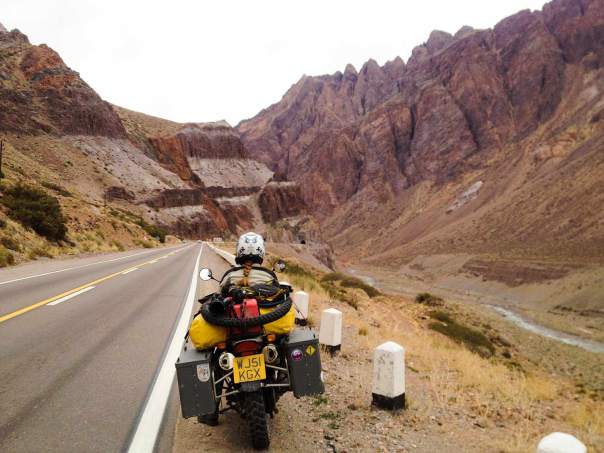
Our return ride to Mendoza was rudely halted on Ruta 60 just before being able to ‘get the knee down’ on the steep ascent of switchbacks up to Portillo, a ski resort on the edge of the Chilean border. Police informed us at the front of a roadblock amid a crowd from a long line of backed-up traffic that the delay would cost us an hour’s wait. Good time to feed our faces and chat to some likely locals. During the time it cost for Jason to grab us a bite to eat, a mere 60 minutes setback had turned into 24 hours. Bugger, we were going nowhere. An alleged imminent snowfall up at 3,200 metres later that afternoon meant that us road-users were forced to make alternative arrangements. Oh well, it could be worse.

The ruddy roadblock
A handful of coach-faring Argentinians sought to see if they could help improve our situation, eyeing our eagerness to continue. It was ridiculous to return to Santiago although pitching the tent just off the roadside didn’t altogether appeal either. Our provisions were low, we weren’t exactly falling over discreet places to camp and if snow and her icy sister were looming, my wheels and I would much rather be looking down on the steep zigzagging road, not up. While a few folks and I were attempting to unravel the most likely scenario across an interfering language barrier, a handful of ladies off the coach seized an opportunity to have their photo taken astride Pearl. It was an amuse-bouche she’d got used to dining out on and one which the ladies reveled in when Jason smiled as he gestured, ‘Roll up, roll up! Come on chicas, 10 pesos a go!’ His beckoning body language set them all to giggling.

Informed by a police officer at the barrier that if I could organise for the Portillo Hotel – a choice establishment catering to the Austrian Olympic ski team amongst other ski aficionado holiday makers – to call him directly and confirm our reservation, we were good to proceed. Well, granting us 15 minutes up the steep Scalextric track, a small boon at least. Sounded convoluted to me so I took a punt to proceed through the road blockade regardless. Hoping the police officer would tune into my pitiful puppy-dog eyed plea, I soon realised hell would freeze over before that man would bend to sense, let alone my will. The measured look I received told me that further beseeching him would prove as beneficial as nipples on a motorcross chest plate. Alas I needed to make that reservation. It didn’t mean we had to stay there or even check-in. If the Gods were good, the tunnel leading to the Argentinian border would still be open. The sky was a sun-lit cloudless blue and it was mild. The day promised to see an outbreak of sun-kissed freckles on my face than it did any snowfall.
The time it took to faff, deliberate, make the hotel reservation and land the police officer’s attention to depart, I imagined we could have missed the presumed snow and made it into Argentina, stopping for a Kodak moment with the southern hemisphere’s largest mountain Aconcagua en route. The prospect of paying through the nose for a 4/5 star establishment didn’t entirely flood us with joy. Without further delay, we zoomed past the accommodation and headed straight for the tunnel. We had missed its official closing by less than an hour. Double bugger.
Befuddled, we back-tracked to the hotel and met New Zealanders Monica and Dave in the same predicament as us. Although their wheels were powered by the thigh-burning pedal variety. Neither they nor us could afford to shell out for the only available lodging topside of the hill. Still stumped, I was furiously trying to formulate an idea when Michael the owner of the Portillo hotel ushered me to his private office. Utterly abashed but with nothing to lose I outlined our trip and quandary we found ourselves in with a budget that could ill-afford his standard rate. I proposed a promotional video of his hotel using the quadcopter in exchange for a room rate akin to our meager lodging funds. I was sure the manager would look at me as he might regard a dog who presumed to hump against his leg.
The conversation between us saw the manager: reveal that he loved our story-so-far, decline my proposition to trade Jason’s drone services for a cheap room and his enthusiasm to resolve our plight by an offer to furnish us with a $200 USD room for a sliver of the cost. The hotelier actually asked me how much I would be prepared to pay, which rendered me quite speechless. That was the last response I was expecting. The manager smiled as I pressed him a little further; he agreed to extend this generous gesture towards the cycling couple too. The Morris powers of persuasion had worked tenaciously on this occasion.
In the next moment, we trailed after the housekeeping lady like a procession of ducklings following the mother duck. Within the hour, all four of us were lording it over high tea, one of the four daily meals entitled to even a partially-paying patron, as we peered down incredulously at our ski passes. Refreshed, we wasted not a minute and basked outside neck-deep in a heated swimming pool. It overlooked the mountains under a star-twinkling night sky, steam blurring the beauty of the unforeseen magic that mingles with travellers from time to time.
The impending snow was a day late and wasn’t so much as a forecasted ski-worthy fall but a translucent smattering, lightly lacing the hillsides. The hotel employees’ dismay was ashamedly our delight. The roads remained clear and any ice soon thawed in the morning sun. We awoke to -4 degrees Celsius, departed Portillo mid-morning in 4 degrees and arrived to Mendoza late afternoon in a balmy 14. We’d experienced yet another snowed-in escapade although comfortably admit that we’d both had our fair share of fun on the snow and ice. Guess that’s the nature of Argentina’s wintery beast.
Re-entering Argentina from the Chilean side, we straggled behind half a hundred people keen to return to their home country. We stopped at what can only be described as a drive-thru border crossing. It took everything I had not to ask for two cheeseburgers with extra fries but being on the Chilean side, I thought better not. The best part of the afternoon had past for us to reach customs and them to process us through; with that drawn-out rigmarole under our belts, we were once again allowed on our way.

Mendoza’s local outdoor parilla – grill

In my happy place…
It felt as fine as it did familiar to return to Mendoza and reunite with our buddies we’d made the month previous. Although we weren’t full to the brim with exciting stories from our stay in Santiago, our Mendozian friends had just had a baby. I was smitten at least. During our stay, we feasted on more mouth-watering meaty asados and caught up with new acquaintances in the celebration of Argentina’s Día del Amigo, ‘Friends Day’ with Juan Pablo and his family. The weather had been so darn good, I’d even donned sun cream. A planned couple of nights turned into over a week at both Toto’s digs and Juan Pablo’s house; it was going to be difficult to leave Mendoza. We were rather sweet on these people and their place. It was a wrench to finally go and wave farewell although Pearl brought me round with her endorphin-releasing tonic, my RDA of mood enhancer. It was the balm my soul sighed for – as it always does, my ride.
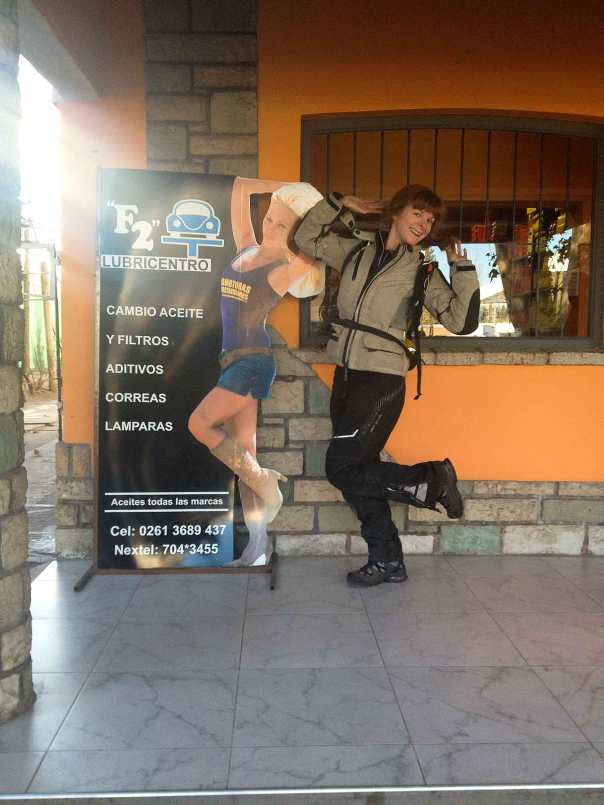
Like for like…?!

Ciao for now guys, hasta pronto! See ya soon
No sooner had we swung a right westward off Ruta 40 back onto the 7 north towards Uspallata, when the cold became cruel. Icy raindrops started to drizzle and pesky pellets of hail began to pour down. My toes were fire-fighting the burn of the cold, all sensation slowly extinguished. Argentina’s autumn had gently kissed us; winter was now starting to bite us hard – its teeth snapping at any exposed strip of flesh. The saving grace was that it gave rise to quite a dramatic scene-stealer; dense clusters of brooding clouds, dark grey steely skies and the purply presence of the Andes with hoarfrost gripping at every low level bush was as Wuthering Heights as I was likely to see this side of the southern hemisphere. We got lucky and hit an unpaved track between the 39 and 412 roads – the first time I’d off-roaded smiling in the snow!

La Pampa del Leoncito

Arriving in Barreal that afternoon felt like someone had turned up the colour saturation in Photoshop. Up to then, I’d been blasé to the bland landscape of wind-tortured plains and dusty mountains, the appearance and texture of elephant skin and had no idea what lay around the corner. I’d read that this part of the San Juan province gave locals around 300 days of ultra-clear, pollution-free skies each year. Like a tap of a wand to a magician’s hat, out popped stark poplar trees, fiercely blue rivers running clear and an ancient, dried out lakebed ‘La Pampa del Leoncito’. Every square centimetre of the 10 kilometre mud-flat was a pattern of cracked crazy-paving. It turned the colour of Maldivian sand when the sun shone down. Needless to say, we spent nigh on an afternoon simulating spirals, figure of eights and playful attempts at crop circles leaving only traces of our tyre-streaked fun. Back in open country, a blending of the soul took place once again by means of my motorcycle and me. A courtesy Pearl never denied me.

The mud turned the colour of Maldivian sand in the sun
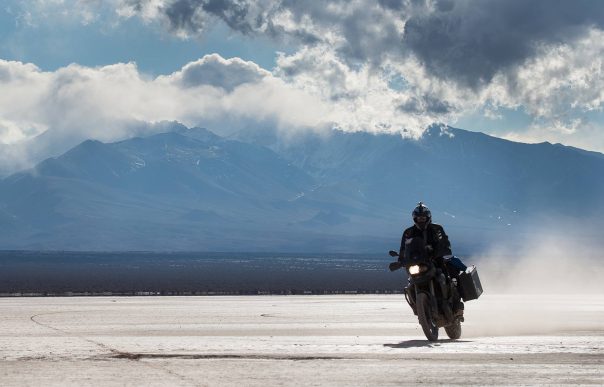
Blasting over the mud-cracked lakebed